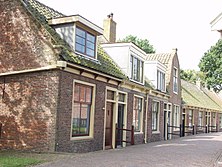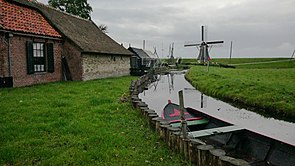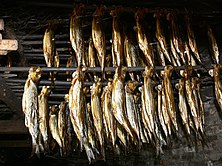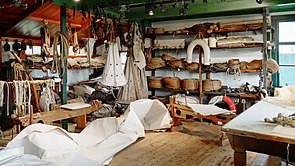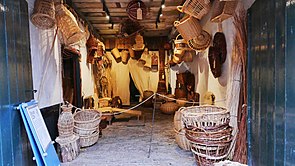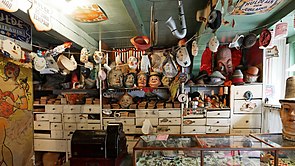Zuiderzeemuseum
The Zuiderzeemuseum , is a Rijksmuseum in Enkhuizen , North Holland province in the Netherlands . It is located near the port of Enkhuizen and is named after the former Zuiderzee (now the IJsselmeer ). The museum was named European Museum of the Year in 1984.
The museum consists of two parts: the Buitenmuseum (outdoor museum), so the open-air grounds , and the inland Museum (Interior Museum), housed in warehouses from the 17th century. The two parts are about 1 km apart and can be reached on foot.
history
The forerunner of the museum is an exhibition on the Zuiderzee, which was shown in 1930 in the Wilhelminapark in Enkhuizen. Houses made of cardboard and residents in traditional costume from the villages around the Zuiderzee were shown. The Second World War initially prevented further development.
In May 1947 the Association of Friends of the Zuiderzee Museum was established and on January 16, 1948 the Royal Decree establishing the Rijksmuseum Zuiderzee Museum was signed. The first director of the museum was Jan Bouma, who during his time as director of the Dutch open-air museum in Arnhem between 1942 and 1948 had already dealt with the plans for a museum about life around the former Zuiderzee. In 1950 the inland museum was opened.
Inland Museum
The Inland Museum consists of a number of in situ preserved and reconstructed 17th century buildings, some of which were previously used by the Dutch East India Company . The main attraction is the "Schepenhal" (ship hall) with an exhibition of historical boats from the formerly important fishery in the Zuiderzee as well as some ships for sailing. Among these boats is the Sperwer (Sperber), a Boeier that was once owned by the English adventurer Merlin Minshall. He used this boat to sail from England over the Danube to the Black Sea on his honeymoon in the 1930s. He later repeated the trip for the English secret service. You can also see a historical “Midzwaardjacht”.
In addition, other exhibits from the Zuiderze region can also be seen. Among other things, paintings, furniture, tools, costumes and a documentation about whaling .
Buitenmuseum (open-air museum)
A typical Zuiderzee town and a fishing village from the period between 1700 and 1900 have been built in the outdoor area. The numerous buildings do not all come from the area around Enkhuizen, but were brought to the museum from various places around the IJsselmeer.
history
The open-air museum in Enkhuizen was opened on May 6, 1983, which is part of the Zuiderzee Museum by Queen Beatrix. The area was previously used by the Zuiderzeewerke as a storage area for the construction of the dam to Lelystad. The first building to be owned by the Zuiderzee Museum in 1948 was the Hindeloopen House . Today it stands on the embankment to the harbor and has housed a cafe since 2016.
description
The open-air museum consists of several parts: the Markerhaven, the church village, the Stadsgracht, the polder, the lime kiln, a water playground for children and a nature area with a picnic area, a duck-catching house and a reconstruction of a West Frisian farm from the Bronze Age . Next to the lime kiln is the port where the boats coming from the parking lot dock.
The Markerhaven harbor is a scaled-down copy of the harbor on the former island of Marken, which was built there in 1840. There are also several buildings from Marken, Volendam and Monnickendam in the port area . These include a slaughterhouse , the reconstruction of the Siberian residence from Marken, a reconstruction of the slipway shed from Marken and a reconstruction of a shipyard, the original of which is in the Dutch Open Air Museum in Arnhem .
The access from the harbor to the church village is via a narrow street that was modeled on the Vuldnerstraat in Harderwijk . This leads over a bascule bridge and has a candy shop, a basket maker and a blacksmith shop .
The first building erected for the open-air museum was the Gasthuiskapel , the chapel of the medieval infirmary in Den Oever . The chapel was rebuilt in the locality based on the model of the church in Oosterend on Texel . Around the chapel is the church village with a post office , bank, printing shop and several craft businesses.
The Stadsgracht (city moat) borders the church village to the east . It is a shopping street from the twentieth century of towns and villages and has been built on the western side as an example of an urban style as a shopping street. On this side there is a butcher, an original cheese warehouse from Landsmeer, a pastry shop and a pharmacy with the famous "Gaper". On the other hand, it is built in Frisian with a rural character. On this side are a number of houses, an agricultural credit bank and another steam laundry.
Behind the Frisian part of the Stadsgracht lies the fishing village. The structure of the fishing village is an almost identical copy of the structure of the village of Zoutkamp in Groningen . A number of buildings from Zoutkamp were able to be rebuilt in their original location . Other houses in the village come from Urk , Moddergat , Vollenhove , Kampen and Monnickendam . The Urk houses stand on a hill - just like in the original. The houses are decorated in the style of 1905. A brush-making shop has been reconstructed in one house .
In the north of the fishing village that lies along the lines of Savoren designed polder . Polders are usually below sea level, which means a constant battle against the water. In the polder there is a mill that can pump the water up if the water level in the trench gets too high. An Archimedean screw is used to demonstrate how the Dutch drained the soil. The fisherman's house from Koehool is in the polder . Fish is smoked in this. Museum visitors have the opportunity to ride on a field barge. Up until the 20th century, farmers used these boats to transport their goods from the field to the farm.
There is a large lime kiln on the other side of the fishing village . In these ovens, mussel shells were burned together with coal or peat to form unslaked lime. After the mussel shells were burned, the lime was brought to the sack house next to the large chimneys and extinguished with sea water. The lime was mainly used for the production of mortar and thus for the production of cement . Due to the availability of the raw materials mussels and water, these ovens were mostly built near the coast.
There is a water playground for children next to the kiln.
particularities
The special thing about the museum is that, at least during the season, mostly volunteer museum employees take on the roles of the villagers in the buildings. So you can craftsmen such as rope-makers , forging , wood shoemakers , but also housewives look in their activities over the shoulder. The work in the bakery , cheese factory and fish smokehouse can also be observed live.
In contrast to most open-air museums, dogs are not allowed into the outdoor area.
As there are almost no parking spaces available in the vicinity of the museum, visitors are brought to the museum by ferry from a car park outside the city and from Enkhuizen train station (journey time approx. 15 minutes). Like a large part of the museum, this ferry is barrier-free and can be used with a wheelchair without any problems.
Web links
Coordinates: 52 ° 42 ' N , 5 ° 18' E



















